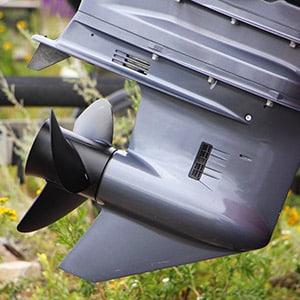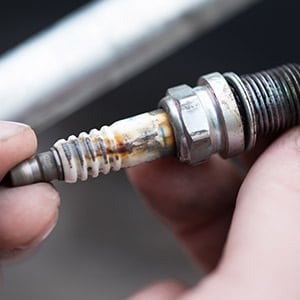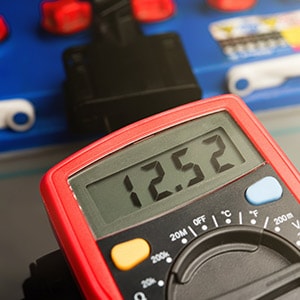
How to Maintain Your Outboard Motor
 When you take your 4-stroke outboard motor out after a long period of non-use, you can't simply install it on your boat and sail. Just like your lawnmower and other seasonal equipment, your outboard motor needs a tune-up at the start of the season.
When you take your 4-stroke outboard motor out after a long period of non-use, you can't simply install it on your boat and sail. Just like your lawnmower and other seasonal equipment, your outboard motor needs a tune-up at the start of the season.
The following outboard motor maintenance tips apply any time you haven't used your motor in a while. They also work for outboard motor troubleshooting. Note that each brand of 4-stroke outboard motor is different, so these are general rules that can be tweaked for your specific unit.
Replace the Oil
Outboard motors use two different types of oil. The engine uses marine-grade oil while the lower unit needs gear case oil to keep the parts moving smoothly. When tuning up your outboard motor at the beginning of the season, you need to drain and replace both lubricants.
To change the engine oil, warm the engine up for a few minutes to loosen it up. Next, pop the hood, remove the dipstick, and use an extraction pump to remove the old oil. Finally, add fresh engine oil into the motor.
To change the lower unit oil, unscrew the drain plugs and allow the oil to spill into a pan. Then, pump in fresh gear case oil. Finally, reinsert the drain plugs immediately to avoid losing oil.
How Often Should You Change the Oil on Your Boat's Engine?
Generally, you should replace your outboard engine and lower unit oil once a year, although always refer to your owner's manual for a specific timetable. You may need to change it more frequently, depending on how often you use your outboard. Shop Honda and Quicksilver brand outboard engine oil.
Check the Propeller
 The propeller, or prop, is the part that moves your boat, so it's crucial to make sure it's working correctly. Use the following steps to remove and inspect the outboard prop.
The propeller, or prop, is the part that moves your boat, so it's crucial to make sure it's working correctly. Use the following steps to remove and inspect the outboard prop.
- Remove the split pin.
- Use a propeller-removing spindle to remove the main nut, washers, and propeller.
- Inspect the propeller shaft for fishing lines or debris that may have gotten lodged last season.
- Grease the propeller shaft and replace the propeller.
- Inspect the propeller blades for any dents and wear. If there are any, you need new blades.
Lubricate Grease Points
Your outboard motor has several grease (zerk) fittings along its surface that provide lubrication for all of the moving parts for steering and tilting. Proper outboard motor maintenance includes locating these fittings and applying water-resistant grease with a grease gun. That way, you will sail smoothly on the water.
Inspect the Spark Plug
 Your outboard motor uses several spark plugs to ignite the engine. You should inspect these regularly to ensure proper ignition.
Your outboard motor uses several spark plugs to ignite the engine. You should inspect these regularly to ensure proper ignition.
To check your outboard motor spark plugs:
- Remove the cover to expose the spark plugs.
- Pop the plug wires (this is a great time to check the plug wires for cracks).
- Loosen the spark plugs and unscrew them. A healthy plug should be a light tan color.
- If the spark plug looks worn, replace it. If it's black, sooty, oily, or otherwise damaged, get a professional inspection.
- Before replacing the spark plug, apply some anti-seize compound to it to prevent it from ever getting stuck.
Inspect the Fuel Lines
If you haven't run the outboard motor in a while, it's essential to check the fuel system. Check the fuel lines and primer bulb for any dry rot or cracks.
Inspect the fuel as well by taking a sample. If you see any water or debris in the fuel,
get a professional inspection done to identify the problem.
Check the Battery
 You need the battery in top working condition to start your engine. Make sure all battery connections are tight on electric start engines. We recommend using nylon nuts for your terminals instead of wingnuts, which come loose easily. Check the cables for dry rot and make sure the terminals themselves are not corroded. Use a battery washer to clean the terminals.
You need the battery in top working condition to start your engine. Make sure all battery connections are tight on electric start engines. We recommend using nylon nuts for your terminals instead of wingnuts, which come loose easily. Check the cables for dry rot and make sure the terminals themselves are not corroded. Use a battery washer to clean the terminals.
Lastly, measure the system voltage.
- Connect a voltmeter to the battery terminals (red lead connects to positive, black to negative).
- Turn the ignition switch on without starting the engine.
- Write down the voltmeter reading.
- Start the engine and measure the voltage again. It should be at least one volt above the number you wrote down. If it's low, you may need a new battery.
Flush the Motor
Flushing your outboard motor is important not only during regular maintenance but also after every use to remove salt and other impurities collected from the water.
To flush your outboard motor:
- Attach motor flushing muffs onto the outboard's water intake valves.
- Connect a hose to the muffs and turn on the motor.
- Let the water run through the motor, cleaning out all the dirt and grime.
Maintenance is Key
To ensure a fun and active boating season, maintaining your outboard motor is a must. Performing the above outboard motor maintenance at the beginning of the season and during the season as needed will let you sail with peace of mind.
![]() NEXT: Browse Marine Maintenance Accessories
NEXT: Browse Marine Maintenance Accessories
Outboard Navigation

Outboard Motor Expert

